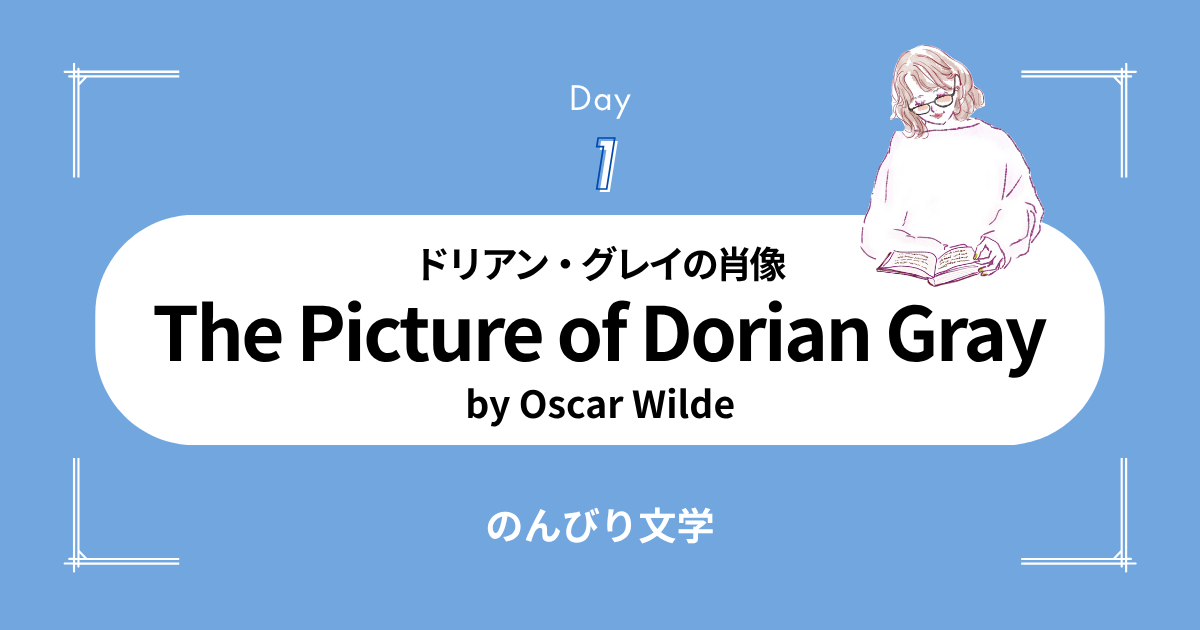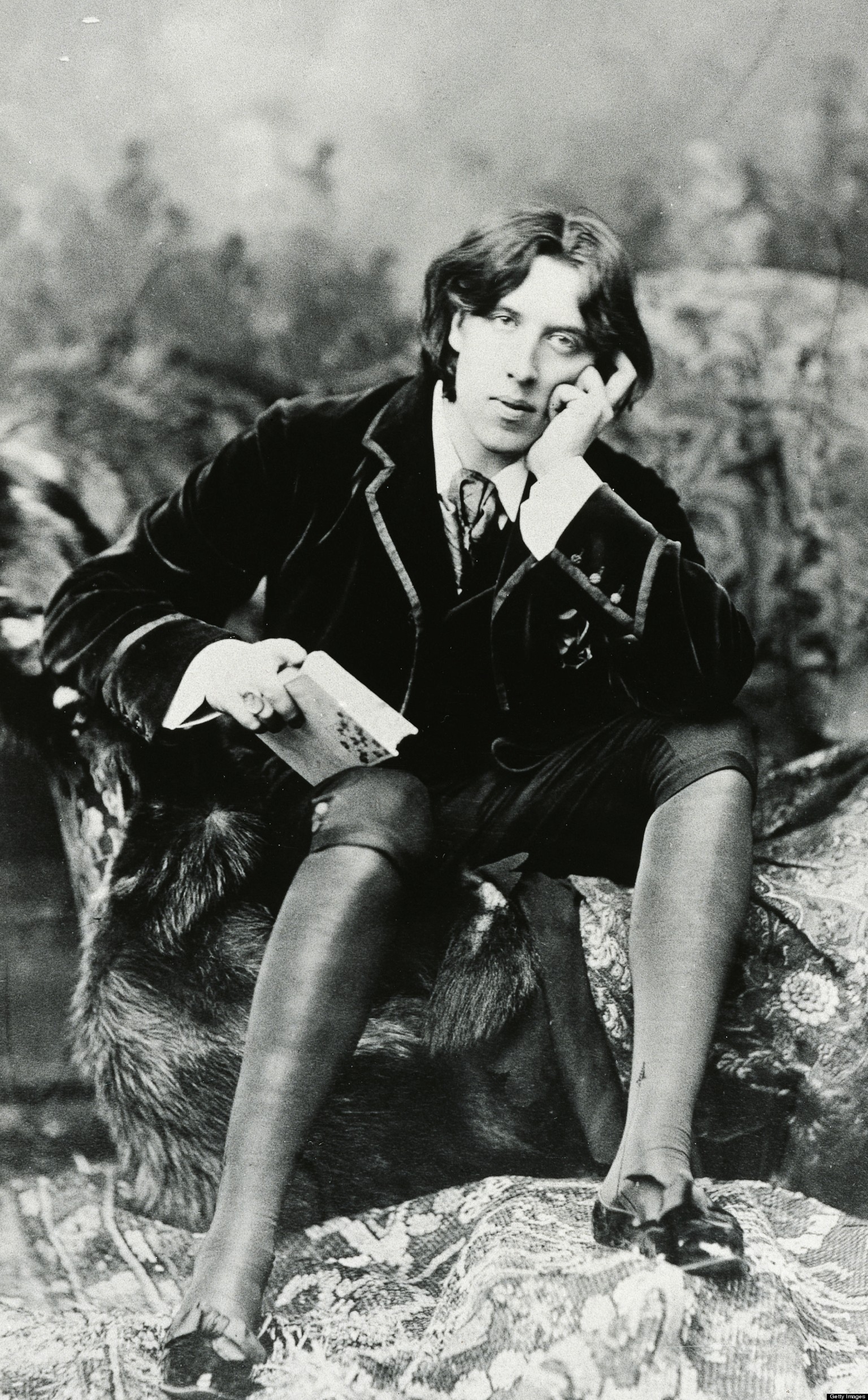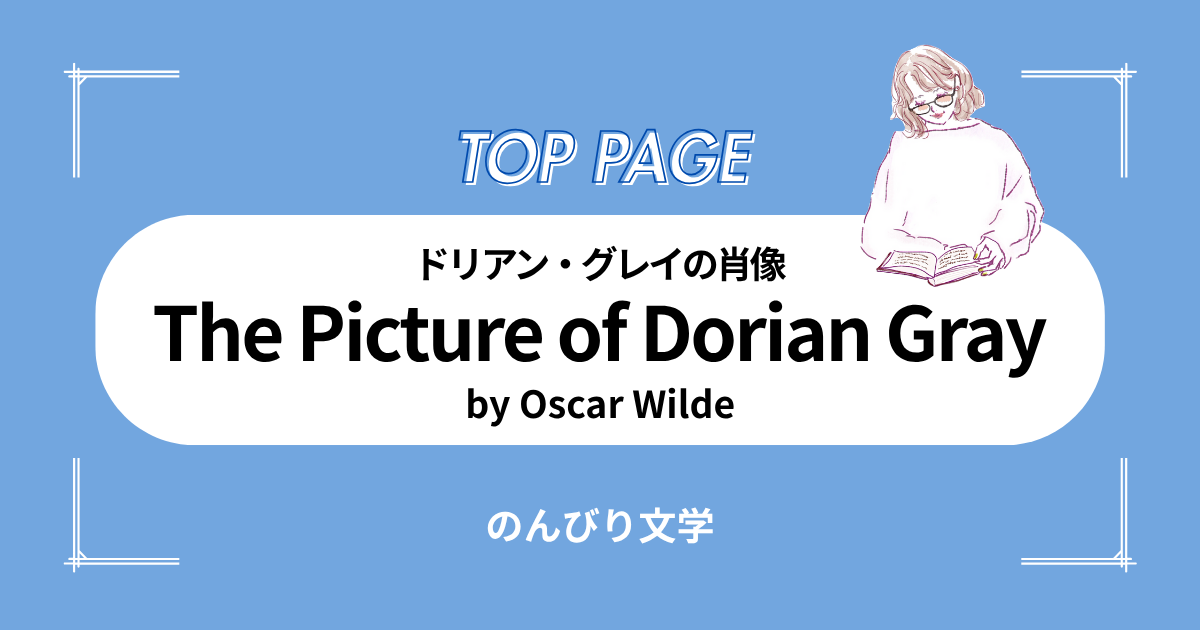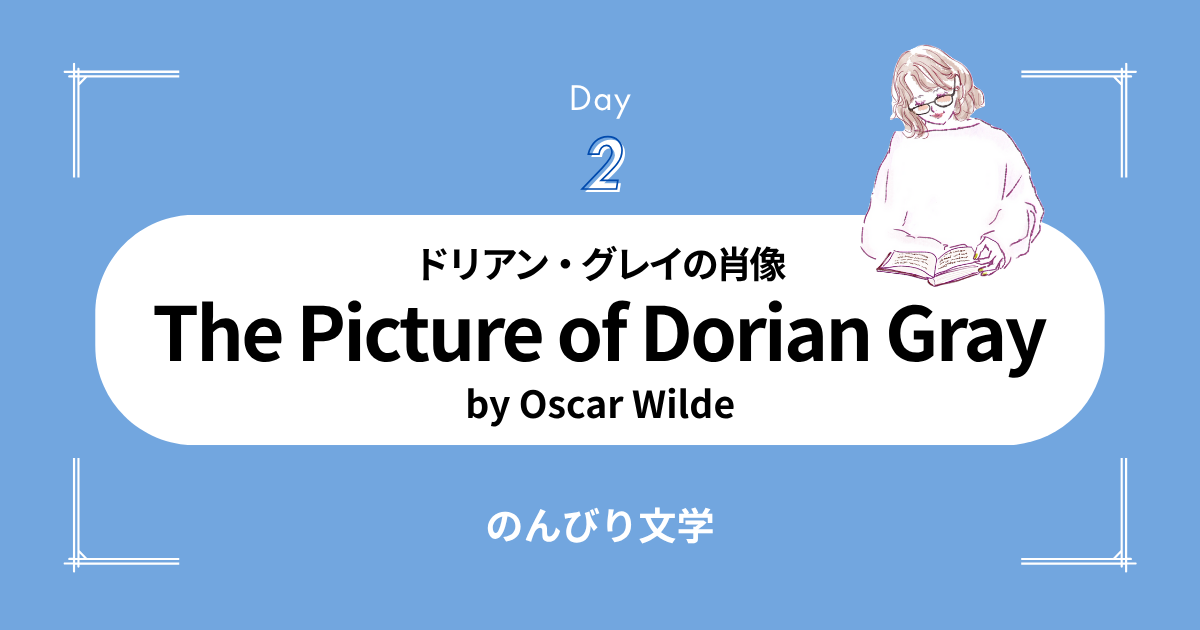【1】オスカー・ワイルドの美学宣言:「ドリアン・グレイの肖像」序文を読む

当サイトでは、著作権切れとなった洋書を扱う Project Gutenberg より、文学作品や小説をDLし、学習の素材として使用しています。
タイトル:The Picture of Dorian Gray(ドリアン・グレイの肖像)
著者:オスカー・ワイルド(Oscar Wilde)
初版発行:1890年(雑誌掲載)/ 1891年(改訂版書籍)
〔あらすじ〕
ロンドン社交界に生きる美青年ドリアン・グレイは、画家バジル・ホールワードに肖像画を描かれます。バジルの友人であり皮肉屋の貴族ヘンリー卿の影響を受け、ドリアンはいつしか自分の「若さ」と「美貌」が永遠ではないことに、恐れを抱くようになっていきます。
そして彼は「老いていくのが自分ではなく、肖像画の中の自分であればよいのに」と願いを込めるようになるのです。そして、その願いは奇跡的に現実のものとなり、ドリアンの姿はいつまでも若く美しいまま。

その代わりに、彼の肖像画がどんどん歳を取っていくのですが、その肖像画はドリアン自身の好ましくない行動の結果を反映して、ひどく醜く変化していきました。
永遠の若さを得た代償に、快楽と退廃の人生を歩むようになっていたドリアン。やがて彼は、その報いに直面することとなるのでした。
この作品は全編を通して 約80,120 words が使われています。
1日に 300~500 words 程度に区切りながら、ゆっくりと読み進めていきたいと思いますので、Day1から順にご自身のペースでお楽しみください。
THE PREFACE〔序文〕
今回は、オスカー・ワイルドの代表作『ドリアン・グレイの肖像』から、物語の “前書き” にあたる序文を取り上げます。
この序文は、美や芸術の意味、批評の在り方についての彼の思想が凝縮されたパートで、ワイルドの美学(Aestheticism)を理解するカギになります。
やや哲学的な文章ですが、初級者にもわかるように語句と表現を丁寧に解説していきます。
文学的な英語表現を学ぶ絶好の素材です。
本文を読む
THE PREFACE
The artist is the creator of beautiful things. To reveal art and conceal the artist is art’s aim. The critic is he who can translate into another manner or a new material his impression of beautiful things.
The highest as the lowest form of criticism is a mode of autobiography. Those who find ugly meanings in beautiful things are corrupt without being charming. This is a fault.
Those who find beautiful meanings in beautiful things are the cultivated. For these there is hope. They are the elect to whom beautiful things mean only beauty.
There is no such thing as a moral or an immoral book. Books are well written, or badly written. That is all.
The nineteenth century dislike of realism is the rage of Caliban seeing his own face in a glass.
The nineteenth century dislike of romanticism is the rage of Caliban not seeing his own face in a glass. The moral life of man forms part of the subject-matter of the artist, but the morality of art consists in the perfect use of an imperfect medium. No artist desires to prove anything. Even things that are true can be proved. No artist has ethical sympathies. An ethical sympathy in an artist is an unpardonable mannerism of style. No artist is ever morbid. The artist can express everything. Thought and language are to the artist instruments of an art. Vice and virtue are to the artist materials for an art. From the point of view of form, the type of all the arts is the art of the musician. From the point of view of feeling, the actor’s craft is the type. All art is at once surface and symbol. Those who go beneath the surface do so at their peril. Those who read the symbol do so at their peril. It is the spectator, and not life, that art really mirrors. Diversity of opinion about a work of art shows that the work is new, complex, and vital. When critics disagree, the artist is in accord with himself. We can forgive a man for making a useful thing as long as he does not admire it. The only excuse for making a useless thing is that one admires it intensely.
All art is quite useless.
OSCAR WILDE
重要単語の確認
reveal /rɪˈviːl/(動詞)
明らかにする、暴露する。「To reveal art」は「芸術を明らかにする」という意味。
conceal /kənˈsiːl/(動詞)
隠す。「conceal the artist」は「芸術家を隠す」。
impression /ɪmˈpreʃən/(名詞)
印象。ここでは「beautiful things」の印象を別の形で表現するという文脈。
cultivated /ˈkʌltɪveɪtɪd/(形容詞)
教養のある、洗練された。美を美として受け取る者を形容。
immoral /ɪˈmɔːrəl/(形容詞)
道徳に反する。moral(道徳的)との対比。
rage /reɪdʒ/(名詞)
激怒。比喩的に使われ、19世紀の美意識を批判。
sympathy /ˈsɪmpəθi/(名詞)
同情、共感。「ethical sympathy(倫理的な共感)」は芸術家にとってスタイル上の過ち。
morbid /ˈmɔːrbɪd/(形容詞)
病的な。芸術家に「病的」はあり得ないと述べている。
peril /ˈperəl/(名詞)
危険。「at their peril(自らの危険で)」という熟語で登場。
覚えておきたい表現
to reveal A and conceal B
Aを明らかにし、Bを隠す
「芸術を明らかにし、芸術家を隠す」が芸術の目的であるという逆説的な構造。
a mode of autobiography
自伝の一形態
批評は批評家自身を語るもの、という皮肉を込めた比喩。
All art is quite useless.
すべての芸術はまったく役に立たない
芸術の価値は「役に立つこと」によって測れない、という美学の核心を象徴する名言。
at their peril
自らの危険をもって
「象徴を読もうとする者は、その危険を自分で負え」という警告的な表現。
forgive A for B
BについてAを許す
「実用的なものを作った者を、それを賞賛しない限り許せる」との文脈で登場。
本文と対訳
The artist is the creator of beautiful things.
芸術家とは、美しいものを創造する者である。
To reveal art and conceal the artist is art’s aim.
芸術を明らかにし、芸術家を隠すことが、芸術の目的である。
The critic is he who can translate into another manner or a new material his impression of beautiful things.
批評家とは、美しいものから受けた印象を別の形や新しい素材に翻訳できる人である。
The highest as the lowest form of criticism is a mode of autobiography.
批評の最高の形も最低の形も、それは自伝の一形式である。
Those who find ugly meanings in beautiful things are corrupt without being charming.
美しいものに醜い意味を見出す者は、魅力もなく堕落している。
This is a fault.
これは欠陥である。
Those who find beautiful meanings in beautiful things are the cultivated.
美しいものに美しさを見出す者こそ教養ある人間であり、
For these there is hope.
彼らには希望がある。
They are the elect to whom beautiful things mean only beauty.
彼らこそ、美しいものにただ美しさだけを見出す選ばれし者である。
There is no such thing as a moral or an immoral book.
道徳的な本や不道徳な本というものは存在しない。
Books are well written, or badly written.
本はよく書かれているか、下手に書かれているか。
That is all.
それだけである。
The nineteenth century dislike of realism is the rage of Caliban seeing his own face in a glass.
19世紀におけるリアリズムへの嫌悪は、鏡に映った自分の顔を見て激怒するキャリバンの怒りである。
The nineteenth century dislike of romanticism is the rage of Caliban not seeing his own face in a glass.
19世紀におけるロマン主義への嫌悪は、鏡に自分の顔が映っていないことに怒るキャリバンの怒りである。
The moral life of man forms part of the subject-matter of the artist, but the morality of art consists in the perfect use of an imperfect medium.
人間の道徳的生活は芸術家の題材の一部にはなり得るが、芸術の道徳とは、不完全な媒体を完全に使いこなすことにある。
No artist desires to prove anything.
芸術家は何かを証明しようなどとは望まない。
Even things that are true can be proved.
真実でさえ、証明できるものである。
No artist has ethical sympathies.
芸術家に倫理的な共感などというものはない。
An ethical sympathy in an artist is an unpardonable mannerism of style.
芸術家が倫理的共感を持つことは、赦されざる様式の癖である。
No artist is ever morbid.
芸術家が病的であることなど決してない。
The artist can express everything.
芸術家はすべてを表現できる。
Thought and language are to the artist instruments of an art.
思考と言語は、芸術家にとって芸術のための道具である。
Vice and virtue are to the artist materials for an art.
悪徳も美徳も、芸術家にとっては芸術の素材である。
From the point of view of form, the type of all the arts is the art of the musician.
形式という観点から言えば、すべての芸術の典型は音楽家の芸術である。
From the point of view of feeling, the actor’s craft is the type.
感情という観点から言えば、俳優の技芸こそがその典型である。
All art is at once surface and symbol.
あらゆる芸術は、同時に表層であり象徴でもある。
Those who go beneath the surface do so at their peril.
表層の奥に踏み込もうとする者は、自らの危険を冒してそうしているのである。
Those who read the symbol do so at their peril.
象徴を読み取ろうとする者も、同じく危険を覚悟しなければならない。
It is the spectator, and not life, that art really mirrors.
芸術が本当に映し出しているのは人生ではなく、観る者自身である。
Diversity of opinion about a work of art shows that the work is new, complex, and vital.
芸術作品について意見が分かれるということは、その作品が新しく、複雑で、生命力があることの証である。
When critics disagree, the artist is in accord with himself.
批評家たちの意見が一致しないとき、芸術家は自らと調和している。
We can forgive a man for making a useful thing as long as he does not admire it.
実用的なものを作った人でも、それを崇拝しない限りは許せる。
The only excuse for making a useless thing is that one admires it intensely.
役に立たないものを作る唯一の言い訳は、それを心の底から愛しているということだけだ。
All art is quite useless.
すべての芸術はまったく役に立たない。
理解度チェック
今日のリーディン範囲について、理解度をチェックしてみましょう。
以下の文の空欄に適切な語を選んでください。
Q1. The purpose of art is to reveal _____ and conceal the artist.
A) beauty
B) art
C) criticism
D) thought
- 解答はここをクリック
-
正解:B
Q2. According to Wilde, those who see ugly meanings in beauty are _ but lack charm.
A) immoral
B) corrupted
C) cultivated
D) critics
- 解答はここをクリック
-
正解:B
Q3. A critic translates his _ of beautiful things into new forms.
A) morality
B) impression
C) autobiography
D) sympathy
- 解答はここをクリック
-
正解:B
Q4. Wilde states that a book is either well written or _ written.
A) poorly
B) morally
C) perfectly
D) artistically
- 解答はここをクリック
-
正解:A
Q5. “All art is quite useless” implies that:
A) Art should be practical
B) Art must serve society
C) Art’s value lies in admiration, not use
D) Art is inferior to literature
- 解答はここをクリック
-
正解:C
まとめ
オスカー・ワイルドの序文は、芸術の価値や批評の本質について、刺激的かつ美学的に語られています。
「役に立たないこと」にこそ価値があるという逆説的な主張は、現代の私たちにも問いを投げかけます。
この難解な序文を丁寧に読み解くことで、英語力だけでなく批判的思考も磨かれます。
次回は「The Picture of Dorian Gray」の本編に入ります。
ぜひ一緒に楽しみながら学びましょう。


